 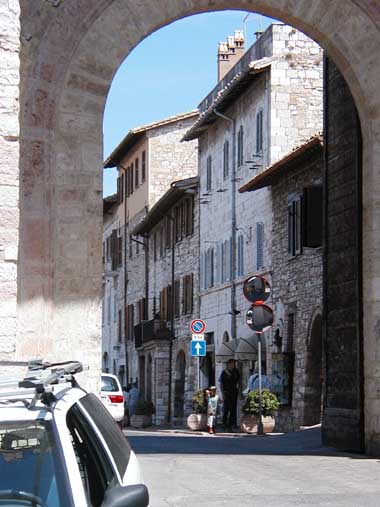
 ESTLED
BETWEEN Marche and Tuscany, Umbria is the only land-locked
region of Italy. Just 150 km from Rome’s Leonardo da Vinci
Fiumicino airport, in the southern reaches of Umbria, sits the small
city of Spoleto. If you love food, wine, visual arts, history and
the performing arts, Spoleto is the place for you. A recent trip
brought me there to discover the culinary delights of the region
while also dropping in on the 46th Festival dei Due Mondi (the Two
Worlds Festival), an annual spectacle of international live music,
dance, visual arts and theatre. ESTLED
BETWEEN Marche and Tuscany, Umbria is the only land-locked
region of Italy. Just 150 km from Rome’s Leonardo da Vinci
Fiumicino airport, in the southern reaches of Umbria, sits the small
city of Spoleto. If you love food, wine, visual arts, history and
the performing arts, Spoleto is the place for you. A recent trip
brought me there to discover the culinary delights of the region
while also dropping in on the 46th Festival dei Due Mondi (the Two
Worlds Festival), an annual spectacle of international live music,
dance, visual arts and theatre.
Founded by the Umbrians in the first century BC,
Spoleto went on to become a Roman colony in the third century. It
is a remarkably beautiful and ancient place surrounded by green
| After just a few days
you feel like part of the community where friendly faces offer
you welcoming ‘buon giornos’ and, as dusk falls, tranquil
‘buona seras’ |
mountains and rolling hillsides. With a history this rich, you can
expect to see countless archæological finds and spy Roman ruins
wherever your feet may take you.
Walking is the best way to explore Spoleto. The
historical town is so small that you often find yourself weaving in
and out of the same narrow cobbled streets, sleepy piazzas, and gushing
fountains. After just a few days you feel like part of the community
where friendly faces offer you welcoming ‘buon giornos’
and, as dusk falls, tranquil ‘buona seras’.
While traipsing the streets of Spoleto, it is remarkable
to see that the elderly are a slim and able-bodied lot, making their
way, with ease, up and down the precipitous alleyways. Their physiques
must be, in large part, due to their diets. Umbria is blessed with
fertile soils, lush green land and plenty of woodland, all giving
way to a multitude of local produce. A trip in the summertime offers
peaches, apricots, cherries, peppers, capers, olives, artichokes and
asparagus, to name but a few.
The cuisine of Spoleto is known for its simplicity.
One guidebook I came across during my stay there described the typical
Spoletina dishes as ‘poor’, though the idea of free flowing
black truffles as part of the poor man’s cuisine seems more like
a fantasy come true to most of us. The fragrant black–brown clump
of fungus is often served as a first course in dishes that are simple
and modest. Restaurants grate tartufo onto plain pasta with olive
oil. Or as in one dish we ate at Tric Trac restaurant, you can watch
it snow upon your risotto as they grate it tableside.
That night we were served a three-course meal and each dish embraced the tartufo
shavings perfectly. Nearly falling off my chair, I was convinced that if a scent of truffles
were integrated into the next designer perfume it would make millions. The mere fuss
from our table alone was testament to the passion such a scent can tap into, and in a very
primal sort of way.
Another dish that we enjoyed there, and one that we tasted throughout our visit, was the
crescionda dessert. This is a Spoletina dish that dates back to the ninth century. Again it
revels in simplicity and can be described as a soft tart. Ingredients comprise of amaretto
cookies, dark chocolate, flour, eggs, sugar, milk and butter. A slice is almost always
served with a dusting of powdered sugar and the best ones are light but carry all the
associations of comfort food.
Eating at Ristorante Tric Trac was a near religious experience and perfectly situated just
across the cathedral of Santa Maria Assunta, also known as the Duomo. From the exterior
it is a humble Roman cathedral that was built in the latter part of the twelfth century. The
outside structure is made up of simple rose windows, a series of arches, a bell tower and a
mosaic of Christ, the Madonna and St John. Inside, the Duomo becomes more spectacular
featuring beautiful mosaic floors and frescos created in later times by Pinturicchio and
Filippo Lippi, all depicting the Virgin Mary. CONTINUED

|
 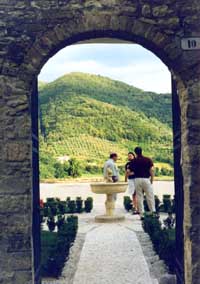
 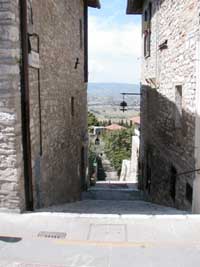
 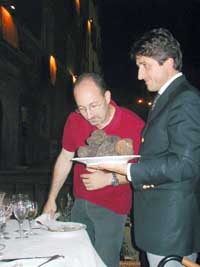
 
 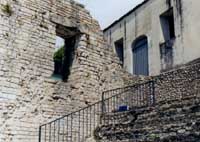
MAIN PHOTOGRAPH:
A street in Spoleto. ABOVE FROM TOP:
The terrace over looking Monte Luco at Hotel Palazzo Leti. A steep
street. Truffles at Tric Trac Restaurant. Plate of truffles are
among mushrooms and other things at Tric Trac. Part of the Roman
Ampitheatre in Spoleto.
|


